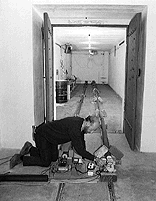
Strainmeter in a San Francisco tunnel monitors the nearby San Andreas fault.
Full size image - 36k.
As the Richter scale does not adequately differentiate between the largest earthquakes, a new "moment magnitude" scale is being used by seismologists to provide a better measure. On the moment magnitude scale, the San Francisco earthquake is estimated at magnitude 7.7 compared to an estimated Richter magnitude of 8.3.

Strainmeter in a San Francisco tunnel monitors the nearby San Andreas fault.
Full size image - 36k.
Intensity is a measure of the strength of shaking experienced in an earthquake. The Modified Mercalli Scale represents the local effect or damage caused by an earthquake; the "intensity" reported at different points generally decreases away from the earthquake epicenter. The intensity range, from I - XII, is expressed in Roman numerals. For example, an earthquake of intensity II barely would be felt by people favorably situated, while intensity X would produce heavy damage, especially to unreinforced masonry. Local geologic conditions strongly influence the intensity of an earthquake. Commonly, sites on soft ground or alluvium have intensities 2 to 3 units higher than sites on bedrock.


